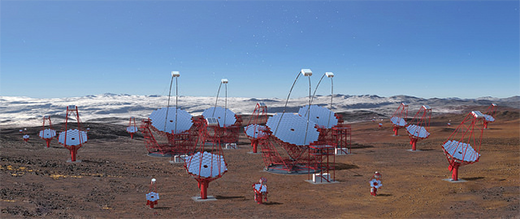| Sep 29, 2021 |
Are pulsars the source of galactic cosmic rays?
|
|
(Nanowerk News) Galactic cosmic rays are created within our galaxy, the Milky Way. They consist predominantly of charged particles, i.e. protons, ions, positrons and electrons that are accelerated under extreme conditions and arrive at the Earth laden with high energy. As photons, or light particles, are created during the acceleration process, gamma rays can also provide clues to the nature of cosmic accelerators.
|
|
The first step towards understanding this phenomenon was taken in 1912, when cosmic rays were discovered by the Austrian physicist Victor Franz Hess. Charged particles are deflected on their long journey to the Earth by interstellar magnetic fields.
|
|
Research into the origin of cosmic rays therefore focuses on non-charged particles such as photons or neutrinos, as they come down to Earth directly and can give us clues as to their site of origin. Alison Mitchell is one of the leading scientists in the world for research into high-energy photons from space, known as gamma rays.
|
|
It is still not known where cosmic rays come from, and whether they originate from one or several source populations. The most promising candidates include supernova remnants, the area around rotating neutron stars, or pulsars, and black holes.
|
|
‘Many colleagues tend to favour supernova remnants, but experiments have so far failed to provide unambiguous proof that this is the case,’ explains Dr. Mitchell.
|
|
The longer ago the stellar explosion took place, the lower the acceleration is expected to be. In addition, theoretical investigations have not yet succeeded in providing convincing evidence that particles in supernova remnants can be accelerated to the extremely high energy levels found in cosmic rays. Scientists are therefore looking for other explanations. Several research groups, for example in France, Poland and the USA, are working on theoretical models indicating that galactic cosmic rays originate in the area around pulsars.
|
|
It was only proven in 2019 that pulsar wind nebulas are capable of accelerating positrons and electrons to energy levels of 1015 electron volts. It follows that the main components of galactic cosmic rays, in other words protons and ions, may also originate from the area around a pulsar.
|
|
In her work at FAU, Dr. Mitchell now hopes to provide the anticipated experimental proof that protons are accelerated by pulsars and the area around them. ‘As far as I am aware, the extensive research programme we are planning is the only one of its kind in the world,’ she explains.
|
On the lookout with gigantic telescopes
|
|
As high-energy particles are hard to find using satellites, researchers are using the Earth’s atmosphere as a detector. Cherenkov telescopes intercept the faint glow that is emitted when a photon from the gamma rays collides with the Earth’s atmosphere.
|
 |
| Artist concept of the Southern site of Cherenkov Telescope Array. (Image: Gabriel Pérez Diaz, IAC, SMM)
|
|
The five telescopes at the HESS observatory in Namibia accurately plot the direction of the gamma rays. Alison Mitchell and other researchers from FAU are also involved in the major international project to build a ground-based observatory for gamma ray astronomy known as the Cherenkov Telescope Array (CTA). ‘As the project progresses, further CTA telescopes with a higher resolution and a wider field of view will be erected on La Palma in the Canary Islands and in Chile,’ explains Dr. Mitchell.
|
|
Algorithms are to be used to improve the resolution of the telescopes. Currently, researchers are also working on new methods aimed at detecting gamma ray sources spread over a wider area. Mitchell believes that thanks to its leading position in the field of theoretical astrophysics and neutrino, X-ray and gamma ray astronomy, FAU offers a very broad range of possible avenues for her project. ‘It is extremely likely both supernovas and pulsars are responsible for galactic cosmic rays, but I believe that pulsars can accelerate particles to energies thousands of times higher than those attained by supernova remnants.’
|

